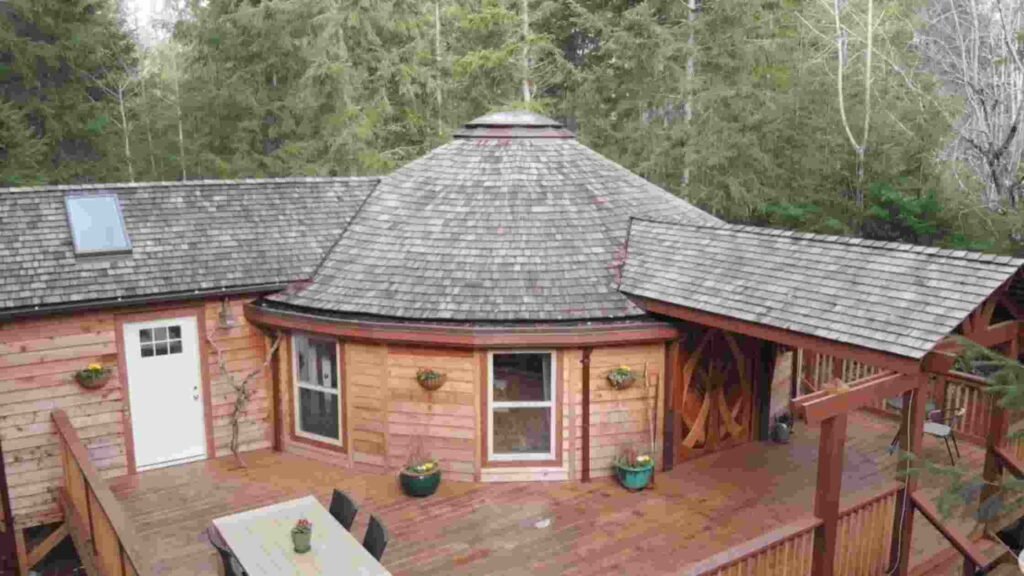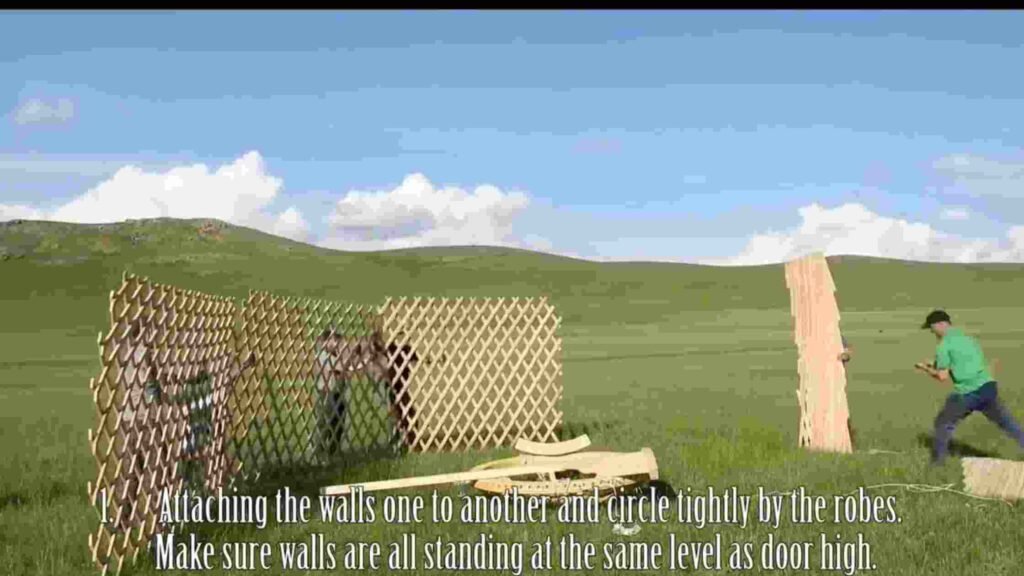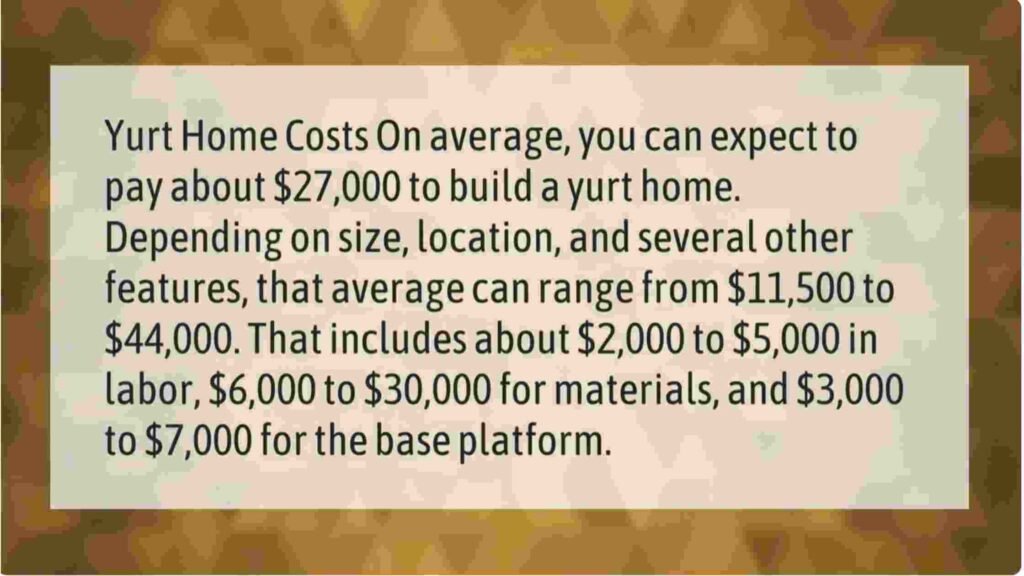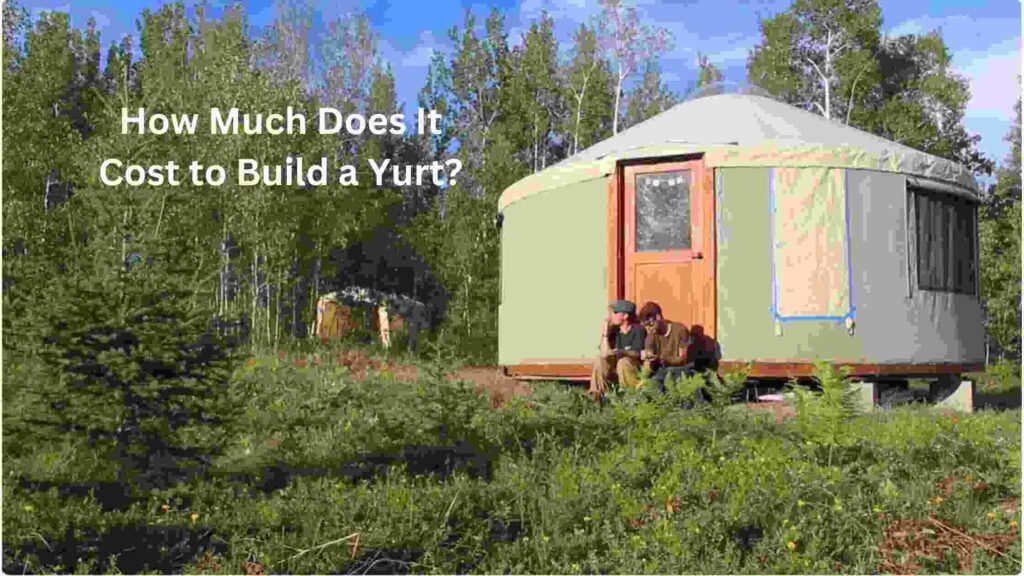The cost to build a yurt typically ranges from $7,000 to $35,000+ (U.S. base kits; platform, utilities, and shipping extra). Factors like size, materials, and customization affect the final price.
Yurts offer a unique blend of traditional charm and modern functionality, striking a balance between tent living and permanent structures. They have gained popularity for their affordability, relatively easy setup, and versatility.
Ideal for those seeking an alternative lifestyle or a cost-effective living space, yurts can serve as primary homes, vacation retreats, or even as commercial spaces like studios or glamping accommodations.
The price of a yurt is influenced by the diameter, the quality of materials such as canvas and wood, and additional features like insulation, windows, or a hardwood floor. Keep reading to understand what contributes to yurt costs and how this flexible dwelling might be the answer to your housing needs.
The Rise Of Yurt Living

The concept of yurt living is capturing hearts far and wide. Yurts provide a unique blend of simplicity and functionality, drawing those eager to embrace minimalistic living. Effortlessly merging with nature, these circular homes offer comfort and a retreat from the bustling modern world. Let’s explore this intriguing lifestyle choice and understand its growing popularity and costs.
Popularity And Modern Uses
Yurts are soaring in popularity across diverse landscapes. Once the traditional dwelling of Central Asian nomads, they now cater to a variety of modern needs, including:
- Glamping sites offer luxurious camping experiences.
- Eco-friendly homes for sustainable living enthusiasts.
- Art studios or workshops, provide serene creative spaces.
- Yoga or meditation retreats that promote peace and tranquility.
Comparing Yurts To Traditional Homes
Affordability often steers the comparison between yurts and traditional homes. The table below outlines the key differences:
| Factor | Yurt | Traditional Home |
|---|---|---|
| Cost | Significantly less | Typically more expensive |
| Build Time | Weeks | Months to years |
| Environmental Impact | Lower footprint | Higher footprint |
| Mobility | Portable | Permanent |
Yurts triumph with their lower cost and reduced environmental impact. They are quick to set up, plus they can move with you. Traditional homes, on the other hand, boast permanency but come with higher expenses and longer construction times.
Basic Components Of A Yurt

Thinking about setting up a cozy yurt? Let’s break down what makes a yurt. A yurt has key parts. Each part is special to keep you comfy and safe.
Structural Elements
The frame is the skeleton of a yurt. It holds up the whole structure. Made of wood or steel, it’s super important for a sturdy yurt.
- Wall lattice: This is what expands to make the walls.
- Rafters: They reach up to the center to support the roof.
- Compression ring: The top where all rafters meet.
Covering Materials
Coverings act like a shield from the weather. Fabric or insulated materials keep heat in and rain out. Three layers often do the job:
- The inner fabric lining for a nice look inside.
- Insulation to stay warm in winter and cool in summer.
- The outer cover stands up to sun, wind, and rain.
Flooring Options
A solid floor means comfort and warmth. Here are the choices:
| Type of Flooring | Pros | Cons |
|---|---|---|
| Wood | Strong and long-lasting | Can be pricey |
| Carpet | Cozy feeling | Needs regular cleaning |
| Laminate | Easy to install | Not as long-lasting as wood |
Size Matters
The cost of building a yurt largely hinges on its size. The larger the yurt, the heftier the price tag. When dreaming of your perfect yurt home, consider how much space you need. So, let’s delve into how size influences the budget, alongside the practicalities of space and utility.
Cost Variations By Diameter
Yurt prices fluctuate with size. Here’s a general breakdown (U.S. base kit prices as of mid-2025; options and shipping extra):
| Diameter (feet) | Cost Estimate |
|---|---|
| 12′ | $9,000 to $12,000 |
| 16′ | $12,000 to $16,000 |
| 20′ | $14,000 to $20,000 |
| 24′ | $18,000 to $25,000 |
| 30′ | $20,000 to $30,000+ |
These are basic figures and can rise with custom features or premium materials.
Space And Utility Considerations
Choosing the right yurt size isn’t just about cost—it’s about functionality.
- Small yurts (12’-16’): Ideal for solo dwellers, seasonal studios, or cozy retreats.
- Medium yurts (20’-24’): Suitable for couples or small families, ensuring comfortable living, dining, and sleeping areas.
- Large yurts (30’+): Perfect for full-time family homes with space for separate rooms and amenities.
Remember, utilities like plumbing and electricity boost functionality, affecting overall costs. Thoughtful planning ensures your yurt meets your lifestyle needs and budget.
Material Choices And Cost Implications

Are you dreaming of owning a yurt? Your choice of materials will make a big difference in cost. Here, we’ll explore the impact of selecting different materials on your yurt’s price tag.
Traditional Vs. Modern Materials
Traditional yurts have been around for centuries. They used natural materials like felt and wood. Modern yurts mix both old and new. They may include materials like vinyl, canvas, and even acrylic. Your material choice influences both the aesthetics and the cost of your yurt.
- Felt – Provides authentic charm, but can be pricier and harder to find.
- Canvas – A common modern choice, more affordable than felt.
- Vinyl and acrylic – Offer durability and are easier to maintain.
Durability And Price
Durability goes hand in hand with cost. Long-lasting materials tend to be pricier. Yet, investing in them could save money over time.
| Material | Cost | Lifespan |
|---|---|---|
| Canvas | Less expensive | Around 5-7 years |
| Vinyl | Moderate | Up to 15 years |
| Insulated fabrics | Expensive | 20 years or more |
Consider that cheaper materials may cost more in repairs or replacements. Balance initial cost with how long you want your yurt to last.
Labor Costs For Yurt Construction
Building a yurt can be a dream project, but labor costs for yurt construction are a crucial factor. Whether taking a hands-on approach or hiring professionals, understanding labor expenses helps budget effectively. This section discusses the costs and considerations when constructing a yurt.
Diy Building Vs. Professional Assembly
DIY building presents a cost-saving opportunity. It requires time, effort, and basic construction skills. You’ll save money but invest personal time and physical labor.
Professional assembly, on the other hand, ensures expert building at a higher cost. A team will complete the project quickly and with guaranteed quality.
Consider these points when deciding between DIY and professional yurt assembly:
- Time commitment: DIY takes longer; professionals are faster.
- Skills: Do you have the necessary abilities, or should you pay for expertise?
- Cost difference: Balance savings versus the value of professional work.
Required Skill And Labor Intensity
Building a yurt is labor-intensive. Skills in carpentry and construction are beneficial. The level of complexity can vary among yurt kits.
Typical tasks include creating a foundation, erecting walls, and installing insulation. The degree of difficulty influences labor costs.
Labor costs factors:
| Task | DIY | Professional |
|---|---|---|
| Foundation | Low Cost | Higher Cost |
| Walls | Moderate Cost | Higher Cost |
| Insulation | Variable Cost | Higher Cost |
If you have the skills, DIY can be rewarding and more economical. Without experience, consider hiring experts to avoid costly mistakes and ensure a sturdy, long-lasting yurt.
Interior Furnishings And Amenities
Crafting the perfect interior for your yurt can range from basic comforts to luxurious living spaces. Each furnishing and amenity choice will directly affect the overall cost. Understand what’s essential and what counts as a lavish extra to plan your budget.
Fundamental Living Necessities
Essential items are a must to turn any yurt into a livable space. The basics include beds, seating, storage, and lighting. These necessities ensure the yurt is functional and comfortable.
- Beds: A simple frame and mattress might cost $200-$500.
- Seating: Couches and chairs could run $100-$400 each.
- Storage: Shelves and cabinets for organization come in at $50-$200.
- Lighting: Basic lighting solutions can range from $20-$100.
Luxury Upgrades And Their Costs
Desiring more comfort? Luxury upgrades can elevate your living experience. These include upgraded furnishings and high-end amenities.
| Luxury Item | Cost Range |
|---|---|
| Designer Furniture: | $500 – $2,000+ |
| High-End Appliances: | $300 – $3,000+ |
| Smart Home Features: | $100 – $1,000+ |
| Custom Woodwork: | $1,000 – $5,000+ |
Consider items like handcrafted tables, luxury bedding, or state-of-the-art sound systems. Remember that these touches, while exquisite, will increase your budget.
Additional Expenses To Consider
Understanding the full cost of building a yurt goes beyond the price of the structure itself.
Envisioning your dream yurt is just the beginning. It’s essential to account for all potential expenses. Ignoring additional costs can lead to surprises. Let’s dive into these often-overlooked areas.
Infrastructure And Utilities
Setting up your yurt involves more than assembly. Infrastructure and utilities are vital for comfort and functionality.
- Water: Will your yurt have running water? This requires a well or connection to local water services.
- Electricity: Planning for electrical wiring and power is crucial. Consider the cost of connecting to the grid or for solar panels.
- Sewage: Septic systems or connections to municipal waste services are important investments.
- Access Roads: Creating a path to your yurt isn’t always easy or cheap. Think about the construction of a driveway or road.
Estimating each element ensures a functional yurt living experience.
Permitting And Legal Fees
Navigating the legal landscape is a crucial step in yurt construction.
Local laws vary widely. Ignorance of permitting can lead to costly fines. Researching and securing the proper permits is imperative.
| Type of Fee | Expected Range |
|---|---|
| Building Permits: | Varies by location |
| Land Use Permits: | Dependent on zoning laws |
| Inspection Costs: | Mandatory for safety compliance |
| Legal Consultation: | Advisable for navigating codes and regulations |
Planning for these fees ensures your yurt project meets all legal requirements.
Price Ranges And Budget Planning
Building a yurt offers a unique blend of comfort and adventure. It demands careful financial consideration. Today’s yurt market presents a spectrum of prices. They range from budget-friendly DIY kits to bespoke luxury abodes. Let’s explore the cost implications and smart budget strategies for yurt enthusiasts.
Estimating Total Costs
Several factors dictate the price of a yurt. These include size, materials, and additional features. A basic, small yurt may start at $7,000–$9,000. Medium to large yurts can cost up to $30,000+. Customizations and premium materials inflate the price marginally.
| Yurt Size | Basic Model | Luxury Model |
|---|---|---|
| Small (12′ diameter) | $7,000 – $9,000 | $10,000+ |
| Medium (20′ diameter) | $12,000 – $18,000 | $20,000+ |
| Large (30′ diameter) | $20,000 – $25,000 | $30,000+ |
Extras like insulation, windows, or a wood stove further affect the total cost. Including these can add $2,000 to $5,000 to the base price. Remember to factor in delivery and setup fees, which vary by manufacturer and distance.
Financial Tips For Aspiring Yurt Owners
Owning a yurt requires a pragmatic approach to spending. It’s not just about the purchase; ongoing maintenance and initial setup fees add up. Here’s how to make your yurt dream financially feasible:
- Set a clear budget that includes all estimated costs.
- Consider a smaller yurt to minimize expenses.
- Research different yurt manufacturers for the best deals.
- Opt for a financing plan if upfront payment is challenging.
- Invest in quality materials to reduce long-term costs.
- Do-it-yourself (DIY) options can slash costs if you’re handy.
- Prepare for unexpected expenses with a contingency fund.
It’s wise to compare offers from different companies. Always read reviews and ask for referrals. A well-planned budget aligns your yurt aspirations with your financial reality, ensuring you enjoy your new dwelling without financial strain.
Maintenance And Upkeep
Embracing a yurt as your home or retreat space captures the imagination with its unique charm. Beyond the initial build cost, considering its ongoing care ensures your yurt remains a haven for years. Let’s explore the essentials of keeping a yurt in tip-top shape.
Routine Care Expenses
Regular maintenance keeps a yurt looking new and functioning well. Every yurt owner should plan for these costs:
- Cleaning supplies for the canvas or exterior cover.
- Clearing debris from the roof and surrounds to prevent damage.
- Inspecting and tightening the lattice framework yearly.
- Seasonal treatment of wood components to prevent rot and pests.
Annual costs can vary depending on materials and climate. Budget around $100 to $300 for basic care items and your time.
Long-term Maintenance Budgeting
Long-term care extends a yurt’s lifespan. Consider these less frequent but crucial tasks:
| Task | Frequency | Estimated Cost |
|---|---|---|
| Replace the top cover | Every 10-15 years (standard); premium covers often last 15-20+ years | Varies by size/fabric |
| Reapply wood finish | Every 2-4 years | $100-$500 |
| Insulate for efficiency | Initially and check annually | $250-$750 |
Long-term upkeep costs vary by the quality of materials and local weather. Allocate $500 to $3,000 every few years for these expenses.
Real Stories From Yurt Dwellers
Curious about the cost of embracing a simpler life in a yurt? Real yurt dwellers share their experiences. They reveal the true costs of building these unique homes. Their stories are full of savvy tips and clever budgeting strategies.
Case Studies
Emily and Jake’s Upstate Retreat: They spent $10,000 for a cozy, insulated yurt. They chose a 20-foot diameter option. Solar panels and a wood stove were added for off-grid living.
Liam’s Mountain Sanctuary: With a budget of $18,000, Liam got a fully customized 30-foot yurt. His includes a kitchen and a bathroom. Local materials helped keep costs down.
Budget Breakdowns And Cost-saving Tricks
- Structure Costs: Prices range from $7,000 to $35,000+.
- DIY Installation: Many save by building their yurt.
- Purchase Used: Second-hand yurts are often half the price.
- Shop Local: Local materials and labor can cut costs significantly.
For a more detailed look, let’s dive into the specifics:
| Item | Average Cost |
|---|---|
| Basic Yurt Kit | $7,000 – $12,000 |
| Platform and Flooring | $1,000 – $3,000 |
| Interior Finishing | $2,000 – $5,000 |
| Utilities (Optional) | $500 – $5,000 |
Mary, a frugal yurt owner, shares a trick: she bought a second-hand yurt for $3,000. With a modest revamp, it’s as good as new. Making smart choices on materials and doing some work yourself can mean huge savings. The rewarding experience of creating a personalized yurt is priceless.
Frequently Asked Questions How Much Does It Cost to Build a Yurt?
Are Yurts Expensive To Build?
Yurts can be cost-effective, with prices varying from several thousand to tens of thousands of dollars, depending on size and amenities.
What Are The Disadvantages Of A Yurt?
Yurts can lack sound insulation, leading to noise disturbances. They may need engineering upgrades to meet heavy snow or high-wind requirements in some locations. Traditional yurts offer limited privacy due to their open layout and thin walls. The semi-permanent nature restricts relocation ease and frequency.
How Long Will A Yurt Last?
A modern yurt’s fabric cover typically lasts about 10 to 15+ years, and premium roof fabrics often reach 20+ years; the wood frame can last for decades with proper maintenance.
Does A Yurt Need A Foundation?
Yes, a yurt typically requires a foundation or well-built circular platform for stability and longevity; some jurisdictions may require an engineered foundation for permanent occupancy.
Conclusion
Building a yurt taps into both traditional charm and modern eco-consciousness, offering an enchanting living space without a towering price tag. A professionally built yurt can range from $7,000 to $35,000+, largely swayed by size, materials, and added features. Remember, a DIY approach can slash costs significantly.
Embracing this unique dwelling means investing in a simplistic, yet profoundly rewarding, way of life. Ready to start your yurt adventure?


